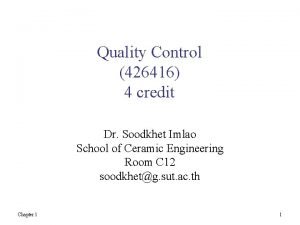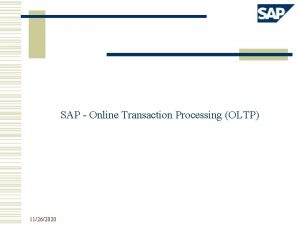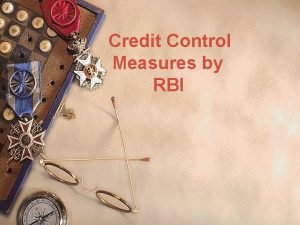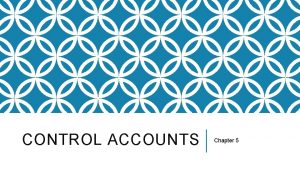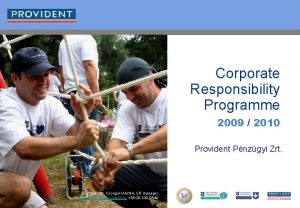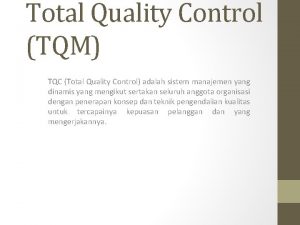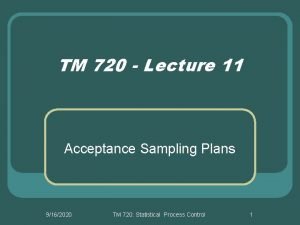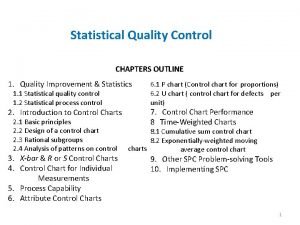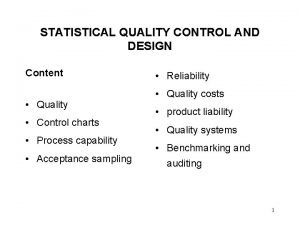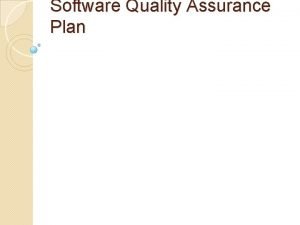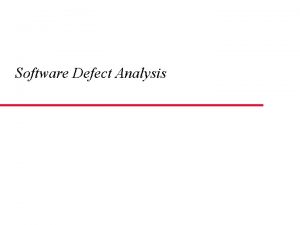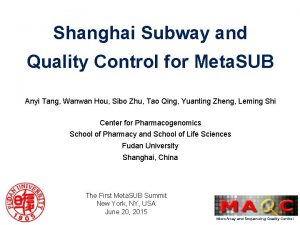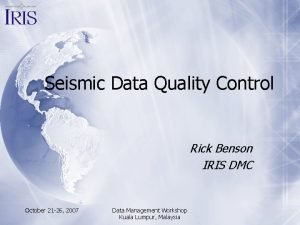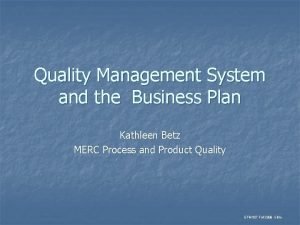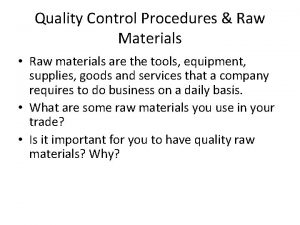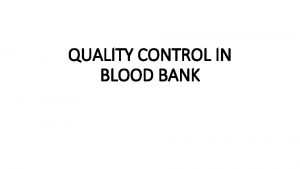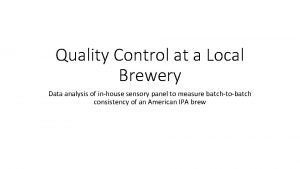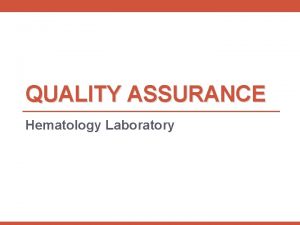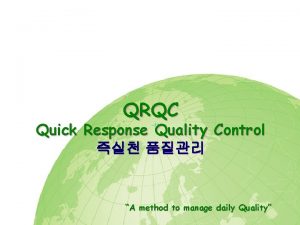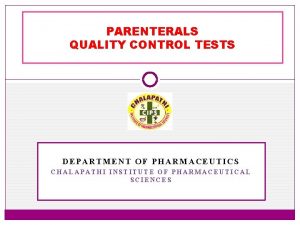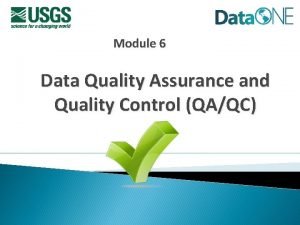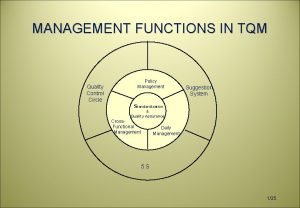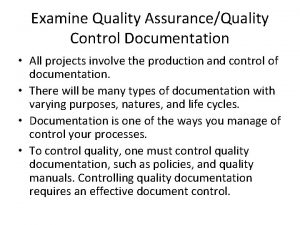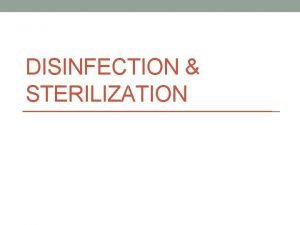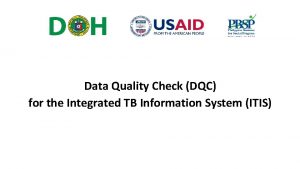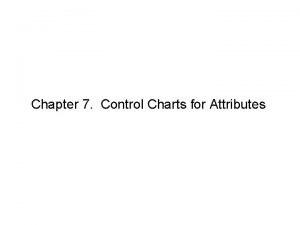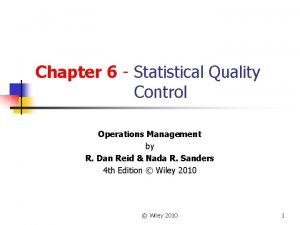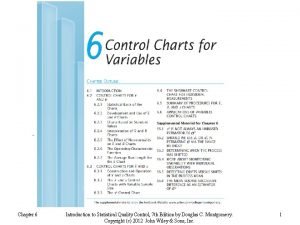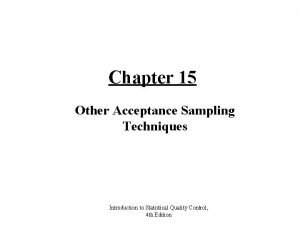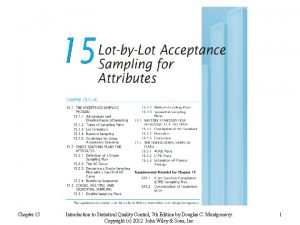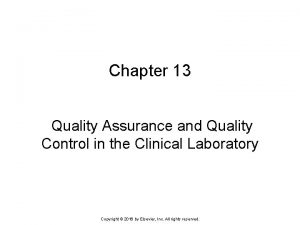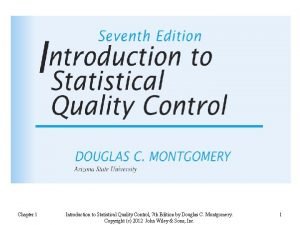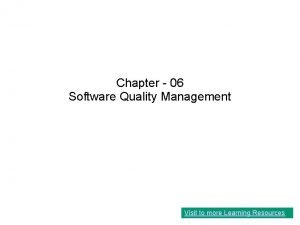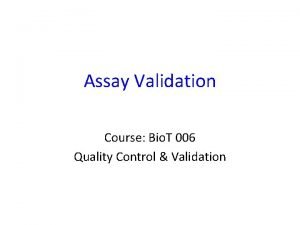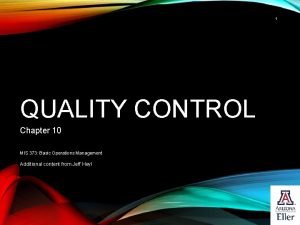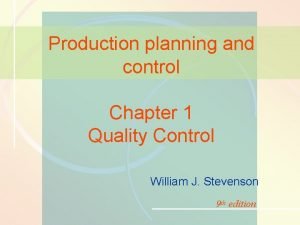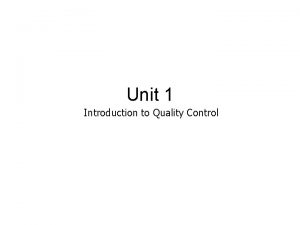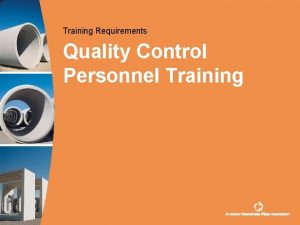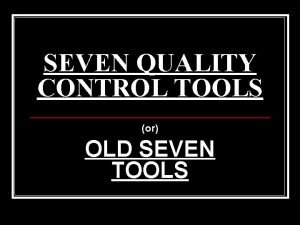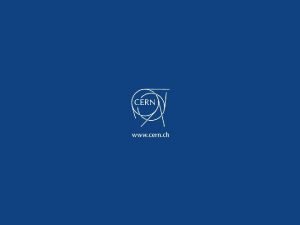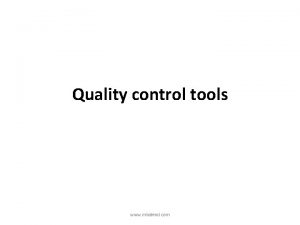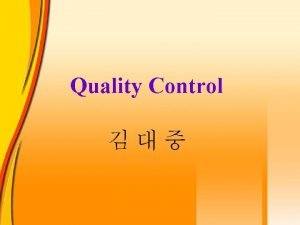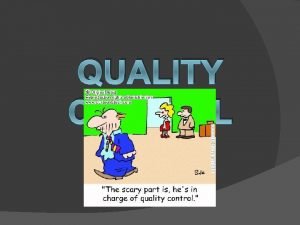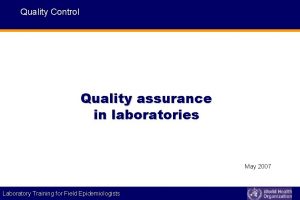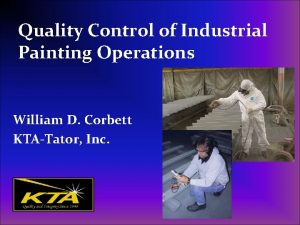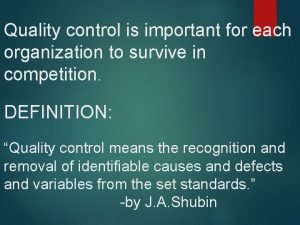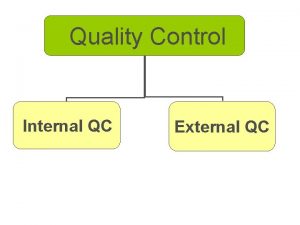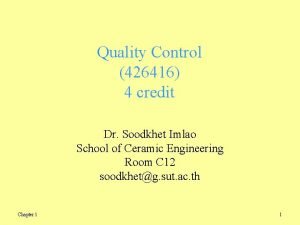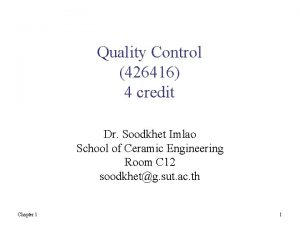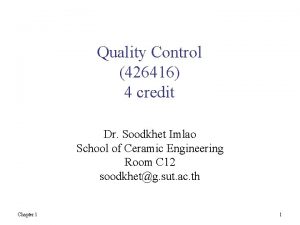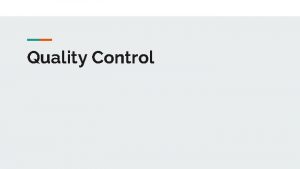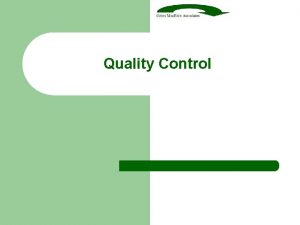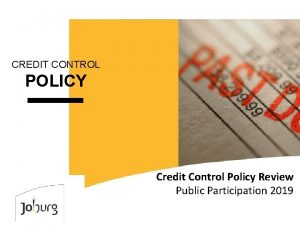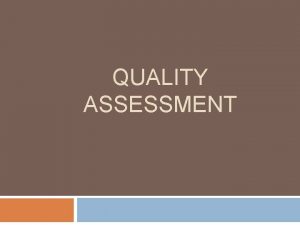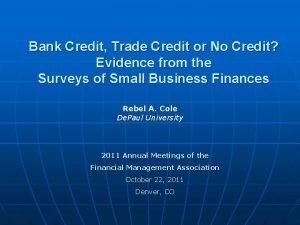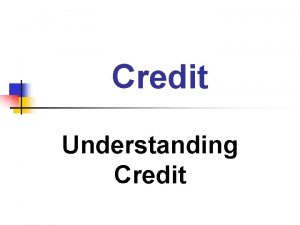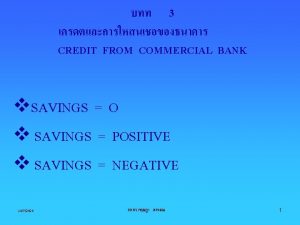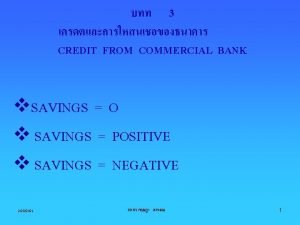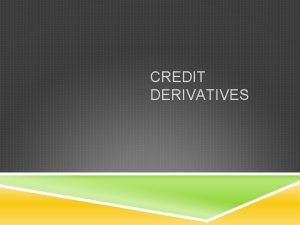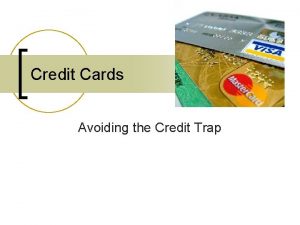Quality Control 426416 4 credit Dr Soodkhet Imlao





























































- Slides: 61

Quality Control (426416) 4 credit Dr. Soodkhet Imlao School of Ceramic Engineering Room C 12 soodkhet@g. sut. ac. th Chapter 1 1

Chapter 1 Introduction to Quality Control Chapter 1 2

Learning Objectives • Define and discuss quality and quality improvement )อภบายเกยวกบคำจำกดความของ คณภาพและ การปรบปรงคณภาพ ( • Discuss the quality management philosophies of W. Edward Deming, Joseph M. Juran, Armand V. Feigenbaum Ishigawa, Kano and กตศกด พลอยพานชเจรญ (อภบาย ปรญญาของการจดการคณภาพ ( • Explain the Shewhart cycle or Deming wheel (PDCA) • Discuss the relationship between: total quality, customer expectation, quality of working life, and quality of product )อภบายความสมพนธระหวางคณภาพโดยรวม ความคาดหวงของลกคา คณภาพของชวตในการทำงาน และ คณภาพของผลตภณฑ ( • Define and discuss costs of quality )อภบายเกยวกบตนทนของคณภาพ ( • Discuss the different dimensions of quality )อภบายเกยวกบมตของคณภาพ ( • Discuss quality standard system (ISO 9000)) อภบายเกยวกบ ISO 9000( • Chapter Discuss a quality award (in Thailand) 1 3 )อภบายเกยวกบรางวลคณภาพของประเทศไทย (

• This is a traditional definition Q: แปลความหมายของ quality สำหรบ classical definition เปนภาษาไทยใหไดใจความ Chapter 1 4

This is a modern definition of quality by Montgomery Q: แปลความหมายของ quality สำหรบ modern definition เปนภาษาไทยใหไดใจความ Chapter 1 5


• The transmission example (Fig. 2 in page 6) illustrates the utility of this definition • An equivalent definition is that quality improvement is the elimination of waste. การพฒนาคณภาพคอการลดความแปรปรวนของกระบวนการและผลตภณฑ หรอคอการกำจดสวนทเสย Variation or waste Chapter 1 7

Quality definition Quality can be quantified as follows*: *Dale Besterfield Chapter 1 8

Who is our customers ? • Internal customers – หนวยงานทรบงานตอจากเรา • External customers Customers are the next process – ผทซอสนคาหรอบรการจากองคกร Chapter 1 9


Definition of quality from gurus • กตศกด : ไดใหนยามของคณภาพตามววฒนาการดานอตสาหกรรม – ยคการผลตเชงมวล (mass production, industrial revolution 1920 -1950) คณภาพคอการตรงตอขอกำหนดเฉพาะ (conformance to specification) ซงหมายถงเกณฑทใชตรวจสอบคณภาพของผลตภณฑทไดออกบบมา – ยคแหงการแขงขน (After WWII, 1950 -1980) คณภาพคอการสรางความพงพอใจใหแกลกคา (customer satisfaction) – ยคโลกาภวตน (globalization) คณภาพคอการสรางความประทบใจใหแกลกคา (customer delight)หรอสรางคณภาพทเหนอกวาความคาดหวงของลกคา ซงจดเปนกลยทธในการสรางความสามารถในการแขงขนทางธรกจ (business strategy) • ISO 9000: 2000 quality is defined as the degree to which a set of inherent characteristics fulfills requirements. – Degree = quality can be used with adjective such as poor, good, and excellent. – Inherent = defined as existing in something, especially as a permanent characteristic. – Characteristic can be quantitative or qualitative. – Requirement is a need or expectation that is stated; generally implied by the organization, its customers, and other interested parties Chapter 1 11

History of Quality Improvement Work standard (Taylor) Assembly line (Ford) Control chart (Shewhart) Chapter 1 12

History of Quality Improvement QC in JP Deming Cause-andeffect diagram Ishigawa Chapter 1 13

History of Quality Improvement TQC ไฟเกนบวม QC in JP Juran Chapter 1 14


Quality before Industrial Revolution (1700 – 1900) Quality = goodness, interchangeable • 1700 -1900: Craftsmanship )������ ) ������������������������ • : 1798 Eli Whitney �������������������� (interchangeability) ������������������������ Chapter 1 16

Quality after Industrial Revolution (1900 -1945) Quality = conformance to specification • 1900 -1930: Henry Ford �������������� (assembly line) �������������� � • : 1924 Shewhart ����������� (control chart) ������ Bell Laboratories • : 1928 H. F. Doge ��� H. G. Roming �������������� (Acceptance Sampling methodology) �������������� • 1941 -1945 (WW II): Bell Laboratories �������������� Chapter 1 17

After WW II (1946 -1980) Quality = customer satisfaction • 1946 -1949: Deming ������������������������ • : 1951 A. V. Feigenbaum ������������ (Total Quality Control( • : 1950 Ishigawa: �������� Cause-and. Effect diagram �������������� • : 1954 Juran 18 Chapter 1 ������������

Globalization Quality = customer delight • 1987: ������������ ISO 9000 • : 1988 ������������ (Malcolm Baldrige Award) ������������ (European Quality Award( • : 1991����������� ���. /ISO 9000 • : 1989������ Motorola ��� GE Chapter 1 19 ������������


The Quality Gurus • • • Chapter 1 Walter Shewhart W. Edwards Deming Joseph M. Juran Kaoru Ishikawa Armand Feigenbaum Noriaki Kano 21

Key Contributors to Quality Management Chapter 1 22

Walter A. Shewhart (1891 -1967) • Trained in engineering and physics • Long career at Bell Labs • Developed the first control chart about 1924 Chapter 1 23

W. Edwards Deming (October 14, 1900 – December 20, 1993) • Taught engineering, physics in the 1920 s, finished Ph. D in 1928 • Met Walter Shewhart at Western Electric • Long career in government statistics, USDA, Bureau of the Census • During WWII, he worked with US defense contractors, deploying statistical methods • Sent to Japan after WWII to work on the census Chapter 1 24

Deming’s 14 Points 1. Create constancy of purpose toward improvement 2. Adopt a new philosophy, recognize that we are in a time of change, a new economic age 3. Cease reliance on mass inspection to improve quality 4. Do not award business to suppliers on the basis of price alone, but also consider quality 5. Improve constantly and forever the system of production and service (focus on continuous improvement) 6. Practice modern training methods and invest in on-the-job training for all employees 7. Improve leadership, recognize that the aim of supervision is help people and equipment to do a better job 8. Drive out fear 9. Break down barriers between departments Chapter 1 25

Deming’s 14 Points 10. Eliminate slogans and targets for the workforce such as zero defects 11. Eliminate numerical work standards 12. Remove barriers that discourage employees from doing their jobs 13. Institute (start) a continuing program of education and selfimprovement 14. Create a structure in top management that will strongly support the first 13 points Chapter 1 14 ขอขางตนนเปนการมงเนนใหมการเปลยน แปลงในระดบองคกร และบทบาทของฝายบรหารมสวนสำคญมากในการเปล ยนแปลงองคกร 26

Shewhart cycle (or Demming wheel): The four steps; Plan-Do-Check-Act, are often called the PDCA cycle Chapter 1 27

Joseph M. Juran • Born in Romania (19042008), immigrated to the US • Worked at Western Electric, influenced by Walter Shewhart • Emphasizes a more strategic and planning oriented approach to quality than does Deming • Juran Institute is still an active organization promoting the Juran philosophy and quality improvement practices Chapter 1 28

The Juran Trilogy 1. Planning : design/develop products or services that meet customer needs 2. Control : to ensure the products or services meet the requirement (Statistical Process Control; SPC is one of the primary tools of cool) 3. Improvement: to achieve performance and quality levels that are higher than current levels Chapter 1 29

Armand V. Feigenbuam – Author of Total Quality Control, promoted overall organizational involvement in quality, – Three-step approach 1. quality leadership 2. quality technology (statistical methods) 3. organizational commitment Chapter 1 30

Noriaki Kano In the late 1970 s and early 1980 s Kano and his colleagues laid the foundation for a new approach to modeling customer satisfaction. Kano believed that not all attributes of product or service performance are equal in the eyes of the customer, and that some attributes create higher levels of customer loyalty than others. Chapter 1 31

The Consequences of Poor Quality • • Chapter 1 Loss of business Liability Productivity Costs 32

How to make good quality products or services? 1. Know customer expectations 2. Understand “big Q” or “total quality” which consists of 2. 1 Quality of working life: QWL 2. 2 Quality of product: QP Chapter 1 33

Customer expectations Latent expectation Desire expectation Standard expectation Basic expectation Chapter 1 34

Quality of working life 1. 2. 3. 4. Chapter 1 Safety (safe condition) Secure (job secure) Moral Productivity affect quality of manufacturing/services 35

Quality of product Customer expectations for products: q, C, D 1. quality characteristic classified as 8 dimensions of quality 2. Cost 3. Delivery Chapter 1 36

Dimensions of Quality 1. Performance )สมรรถนะ)- main characteristics of the product/service 2. Aesthetics )รปลกษณ ความสวยงาม, สนทรยภาพ )appearance, feel, smell, taste 3. Special Features )รปลกษณพเศษ ) - extra characteristics 4. Conformance )ความถกตองตามสเปกทกำหนด )- how well product/service conforms to standard or customer’s expectations 5. Reliability) ความนาเชอถอของผลตภณฑ )consistency of performance Chapter 1 37

Dimensions of Quality (Cont’d) 6. Durability )ความทนทาน)- useful life of the product/service 7. Perceived Quality )ความมชอเสยงดานคณภาพ ) - indirect evaluation of quality (e. g. reputation) 8. Serviceability )ความสามารถในการใหบรการ ) service after sale Chapter 1 38

Examples of Quality Dimensions Chapter 1 39

Examples of Quality Dimensions (Cont’d) Chapter 1 40


Examples of Service Quality Dimension Examples 1. Reputation Is the organization well-known? 2. Courtesy Are customer service personnel and the cashier friendly and polite? 3. Consistency Does the organization provide consistent quality of services? 4. Accessibility Is the service center conveniently located? 5. Accuracy Was the problem accurately fixed? 6. Time How long did the customer wait? 7. Timeliness Was the customer service personnel punctual (on time)? 8. Completeness Were the service perfect and did it meet customer expectations? Chapter 1 42


Costs of Quality (continued) • Prevention Costs – All TQ training, TQ planning, customer assessment, process control, and quality improvement costs to prevent defects from occurring • Appraisal Costs – Chapter 1 Costs of activities designed to ensure quality or discover defects : inspection 44

Costs of Quality (continued) • Internal Failure Costs – Costs incurred to fix problems that are detected before the product/service is delivered to the customer. • External Failure Costs – Chapter 1 All costs incurred to fix problems that are detected after the product/service is delivered to the customer. 45

Matching game 1 A B 2 3 C D 4 Chapter 1 46



Delivery • Right time (punctuality) • Right quantity • Right quality Chapter 1 49

Case study of poor service quality control เจบปากไปผาตด -หมอชย ดนขรบจ ปท 60 ฉบบท 18629 วนพฤหสบด แมดช. 12โวยลน ท 22 มกราคม 2552 Question: discuss this case by considering service quality dimensions? Chapter 1 50

Case study of poor service quality control Chapter 1 51

Management Aspects of Quality Improvement Effective management of quality requires the execution of three activities: 1. Quality Planning 2. Quality Assurance 3. Quality Control and Improvement Chapter 1 52

Quality planning Chapter 1 53

Quality Assurance Chapter 1 54

Quality Control and Improvement Chapter 1 55

Quality Systems and Standards Chapter 1 56

• The ISO certification process focuses heavily on quality assurance, without sufficient weight given to quality planning and quality control and improvement Chapter 1 57

The Malcolm Baldrige National Quality Award Chapter 1 58

Chapter 1 59

Chapter 1 60

 Kano model of customer satisfaction
Kano model of customer satisfaction Perform quality assurance
Perform quality assurance Pmp quality vs grade
Pmp quality vs grade Pmbok quality management
Pmbok quality management Basic concepts of quality
Basic concepts of quality This can be avoided by giving credit where credit is due.
This can be avoided by giving credit where credit is due. Define credit control area in sap
Define credit control area in sap Credit control measure of rbi
Credit control measure of rbi Debtors account show dash balance
Debtors account show dash balance Limitations of credit control
Limitations of credit control Define seminar in nursing management
Define seminar in nursing management Compliance vs quality
Compliance vs quality Quality management gurus
Quality management gurus Quality is free: the art of making quality certain
Quality is free: the art of making quality certain Old quality vs new quality
Old quality vs new quality Ipc quality control
Ipc quality control Total quality control tqc
Total quality control tqc Producer's risk
Producer's risk Average run length in quality control
Average run length in quality control Statistical quality control
Statistical quality control Sqa plans
Sqa plans Quality control log examples
Quality control log examples Quality control shanghai
Quality control shanghai Rick benson iris
Rick benson iris Quality control business plan
Quality control business plan Quality control standards
Quality control standards How to inspect and sort raw materials
How to inspect and sort raw materials Quality assurance in blood bank
Quality assurance in blood bank Quality control of fresh fruits and vegetables
Quality control of fresh fruits and vegetables Quality control analysis of beer
Quality control analysis of beer Quality control in hematology
Quality control in hematology Qrqc meeting
Qrqc meeting Clarity test for parenterals
Clarity test for parenterals Quality assurance definition
Quality assurance definition Quality control circle
Quality control circle Quality control documentation
Quality control documentation Sterilization quality control
Sterilization quality control Dqc data quality control
Dqc data quality control Control chart for nonconformities
Control chart for nonconformities What is sqc in operations management
What is sqc in operations management Average run length in quality control
Average run length in quality control What is sampling plan in quality control
What is sampling plan in quality control What is sampling plan in quality control
What is sampling plan in quality control Westgard rules
Westgard rules Montgomery quality control
Montgomery quality control Six sigma methodology defines three core steps
Six sigma methodology defines three core steps Quality control assay
Quality control assay Operations management chapter 10 quality control solutions
Operations management chapter 10 quality control solutions Quality control chart
Quality control chart Introduction to quality control
Introduction to quality control Qc personnel
Qc personnel Aec quality control
Aec quality control Seven quality control tools
Seven quality control tools Quality control approved by rf
Quality control approved by rf Mbaknol
Mbaknol Third party quality control
Third party quality control Quality v
Quality v Internal quality control
Internal quality control Quality control painting
Quality control painting Quality control methods for medicinal plant materials
Quality control methods for medicinal plant materials Quality control functions
Quality control functions Internal qc
Internal qc
